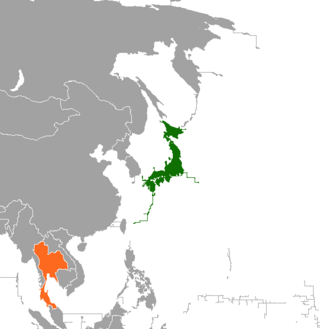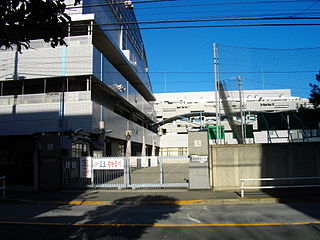Related Research Articles
The Japanese-Language Proficiency Test, or JLPT, is a standardized criterion-referenced test to evaluate and certify Japanese language proficiency for non-native speakers, covering language knowledge, reading ability, and listening ability. The test is held twice a year in Japan and selected countries, and once a year in other regions. The JLPT is conducted by the Japan Foundation for tests overseas, and Japan Educational Exchanges and Services for tests in Japan.

The Eiken Test in Practical English Proficiency, informally Eiken and often called STEP Eiken or the STEP Test, is an English proficiency test conducted by the Eiken Foundation of Japan, a public-interest incorporated foundation. The foundation is backed by the Ministry of Education, Culture, Sports, Science and Technology (MEXT).
Japanese language education in Russia formally dates back to December 1701 or January 1702, when Dembei, a shipwrecked Japanese merchant, was taken to Moscow and ordered to begin teaching the language as soon as possible. A 2006 survey by the Japan Foundation found 451 teachers teaching the language to 9,644 students at 143 institutions; the number of students had grown by 4.8% since the previous year. Aside from one Japanese-medium school serving Japanese people in Russia, virtually all Japanese language education in Russia throughout history has been aimed at non-native speakers. As of 2021, according to the Japan Foundation, 12,426 people were learning Japanese in Russia.
Japanese language education in the United States began in the late 19th century, aimed mainly at Japanese American children and conducted by parents and community institutions. Over the course of the next century, it would slowly expand to include non-Japanese as well as native speakers. A 2012 survey of foreign-language learners by the Japan Foundation found 4,270 teachers teaching the Japanese language to 155,939 students at 1,449 different institutions, an increase of 10.4% in the number of students since the 2009 survey. The quality and focus of dialogues in Japanese textbooks meant for English-speakers has changed since the 1970s. As of 2021, according to the Japan Foundation, 161,402 people were learning Japanese in United States.
Japanese language education in Kazakhstan dates back to 1992; the Japan Foundation's 2006 survey showed 51 teachers teaching the language to 1,569 students at thirteen institutions in Kazakhstan; the number of students increased by 38% as compared to the 2003 survey and more than triple the number in the 1998 survey. As of 2021, according to the Japan Foundation, 611 people were learning Japanese in Kazakhstan.
Japanese language education in Mongolia formally dates back to 1975, when the National University of Mongolia established an elective course in Japanese language. A 2003 survey found 199 teachers teaching 9,080 students of Japanese at 67 different institutions. As of 2021, according to the Japan Foundation, 13,334 people were learning Japanese in Mongolia.
Japanese language education in India has experienced a boom in the early 21st century, helping it to begin to catch up with foreign languages more traditionally popular among Indians, such as French and German. A 2006 survey by the Japan Foundation showed 369 teachers teaching 11,011 students at 106 different institutions; the number of students nearly doubled since the 2005 survey. As of 2021, according to the Japan Foundation, 36,015 people were learning Japanese in India.
Japanese language education in Vietnam first became widespread during the Empire of Vietnam, which was set up as a puppet state after Japan's 1941 World War II invasion of French Indochina. However, after Japan's 1945 surrender and withdrawal from Vietnam, there was little further education in the language until the 1970s. A 2006 survey showed 1,037 teachers teaching 29,982 students at 110 different institutions, an increase of 66% in the number of students since the previous year's survey. As of 2021, according to the Japan Foundation, 169,582 people were learning Japanese in Vietnam.

Brazilian schools in Japan are schools that specifically cater to Brazilians living in Japan. Many students who attend such schools are Fushūgaku (不就学), or children who do not attend public schooling. This is either due to parents wanting their children to attend school in their native language, or because they have little experience with or knowledge of Japanese culture or language.
The Thai Japanese Association School is a Japanese school located in Huai Khwang District, Bangkok on Rama 9 Road. It is sponsored by the Thai-Japanese Association. It is the school with the largest campus in Bangkok, and one of the two Japanese schools in Bangkok. It allows students from junior school Grade 1 students to middle school Grade 3 students to learn. The school only allows students with a Japanese nationality to study.

Japanese migration to Thailand has a long history and in recent years has grown. As of 2021, the Ministry of Foreign Affairs reports that Thailand has the fourth highest number of Japanese expatriates in the world after the United States, China and Australia. Bangkok, the home of two-thirds of all the registered Japanese residents in Thailand, has the second-largest Japanese expatriate population of any city in the world outside Japan, behind only Los Angeles. Japanese residents themselves suspect that their actual population number may be several times higher than the official figures, because many transient residents, especially those on long-term tourist visas, fail to register with Japanese consulates.

The Japanese School of New York, also known as The Greenwich Japanese School (GJS), is a Japanese elementary and junior high school, located in Riverside, Greenwich, Connecticut, near New York City.

Tokyo Korean School is a Korean school located in Wakamatsu-cho, Shinjuku-ku, Tokyo, Japan; catering to the Korean expatriate community and to Japanese-Koreans living in and around Tokyo. It was founded in 1954. It is affiliated with the South Korean government and Mindan (민단). It includes an elementary school, a middle school and a high school. The total population of the school is some 1,100 students. The primary language of instruction at the school is Korean; but there is an English language department and English library at the school. Japanese is also taught as a second language at the school. Educational essentialism is the main educational philosophy of teachers in both the Korean and English departments at the school.

Japanische Internationale Schule e.V. in Düsseldorf is a Japanese international school in Oberkassel, Düsseldorf, Germany.

Japanese School in Moscow is a Japanese international school located in Lomonosovsky District, South-Western Administrative Okrug, Moscow. It was established in 1967. It occupies the fourth and fifth floors of its building, which is also used by the Moscow Finnish School, the Swedish School in Moscow, and the Scuola Italiana Italo Calvino. The campus also has a dining hall, an indoor gymnasium, a technical classroom, a playing field that doubles as a skating rink in the winter, and outdoor athletic fields.

Hoshū jugyō kō (補習授業校), or hoshūkō (補習校), are supplementary Japanese schools located in foreign countries for students living abroad with their families. Hoshū jugyō kō educate Japanese-born children who attend local day schools. They generally operate on weekends, after school, and other times not during the hours of operation of the day schools.
The Japanese Weekend School of New York is a Japanese supplementary school in the New York City metropolitan area. It has its offices in New Roc City in New Rochelle, New York. The Japanese Educational Institute of New York manages the school system, and the JWSNY is one of its two weekend school systems. The JEI also operates two Japanese day schools in the New York area.

Taichung Japanese School is a Japanese international school in Daya District, Taichung, Taiwan in the Republic of China.
Japanese School of Hanoi is a Japanese international school in Nam Từ Liêm, Hanoi, Vietnam. It serves elementary school and junior high school.
Indiana Japanese Language School is a Japanese supplementary school in Indianapolis, Indiana. Classes are held at the Orchard School.
References
- ↑ "2003年海外日本語教育機関調査結果: タイ (Results of the 2003 survey of overseas Japanese language educational institutions: Thailand)". The Japan Foundation. 2006. Archived from the original on July 8, 2007. Retrieved 2008-01-14.
- ↑ "2006年海外日本語教育機関調査結果: タイ (Results of the 2003 survey of overseas Japanese language educational institutions: Thailand)". The Japan Foundation. 2006. Archived from the original on 2008-04-11. Retrieved 2008-01-14.
- ↑ "The Japan Foundation - Survey on Japanese-Language Education Abroad".
- ↑ https://www.jpf.go.jp/e/project/japanese/survey/result/dl/survey2021/All_contents.pdf [ bare URL PDF ]
- ↑ "国際交流基金 - 日本語教育 国・地域別情報 2020年度".
- ↑ "Japanese Language Proficiency Test 2009: Summary of the Results" (PDF). Japan Educational Exchanges and Services, The Japan Foundation. 2009. Archived from the original (PDF) on March 31, 2010. Retrieved 2010-04-20.
- ↑ "Japanese Language Proficiency Test 2008: Summary of the Results". Japan Educational Exchanges and Services, The Japan Foundation. 2008. Archived from the original on July 27, 2009. Retrieved 2009-07-08.
- 1 2 "Japanese Language Proficiency Test 2006: Summary of the Results" (PDF). Japan Educational Exchanges and Services, The Japan Foundation. 2006. Archived from the original (PDF) on 2007-09-28. Retrieved 2008-01-12.
- ↑ "Japanese Language Proficiency Test 2005: Summary of the Results" (PDF). Japan Educational Exchanges and Services, The Japan Foundation. 2005. Archived from the original (PDF) on 2007-01-06. Retrieved 2008-01-12.
- ↑ "Japanese Language Proficiency Test 2004: Summary of the Results" (PDF). Japan Educational Exchanges and Services, The Japan Foundation. 2004. Archived from the original (PDF) on 2005-08-27. Retrieved 2008-01-12.
- 1 2 "Japanese Language Proficiency Test 2003: Summary of the Results" (PDF). Japan Educational Exchanges and Services, The Japan Foundation. 2003. Archived from the original (PDF) on 2004-11-17. Retrieved 2008-01-12.
- ↑ "The 2001 Japanese-Language Proficiency Test Number of Examinees by Sites". The Japan Foundation. 2002-02-14. Archived from the original on 2003-04-07. Retrieved 2006-12-03.
- ↑ "The 2000 Japanese-Language Proficiency Test Number of Examinees by Sites". The Japan Foundation. 2001-02-07. Archived from the original on 2003-04-07. Retrieved 2006-12-03.
- 1 2 3 "The 1999 Japanese-Language Proficiency Test Number of Examinees by Sites". The Japan Foundation. 2000-02-07. Archived from the original on 2000-10-18. Retrieved 2006-12-13.
- ↑ "13th JLRT (2006): A Summary Report" (PDF). Japan External Trade Organization. 2006. Archived from the original (PDF) on 2007-09-27. Retrieved 2008-01-12.